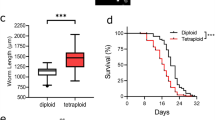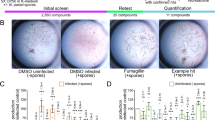Abstract
Naphthalene (1) and para-dichlorobenzene (PDCB, 2), which are widely used as moth repellents and air fresheners, cause cancer in rodents and are potential human carcinogens. However, their mechanisms of action remain unclear. Here we describe a novel method for delivering and screening hydrophobic chemicals in C. elegans and apply this technique to investigate the ways in which naphthalene and PDCB may promote tumorigenesis in mammals. We show that naphthalene and PDCB inhibit apoptosis in C. elegans, a result that suggests a cellular mechanism by which these chemicals may promote the survival and proliferation of latent tumor cells. In addition, we find that a naphthalene metabolite directly inactivates caspases by oxidizing the active site cysteine residue; this suggests a molecular mechanism by which these chemicals suppress apoptosis. Naphthalene and PDCB are the first small-molecule apoptosis inhibitors identified in C. elegans. The power of C. elegans molecular genetics, in combination with the possibility of carrying out large-scale chemical screens in this organism, makes C. elegans an attractive and economic animal model for both toxicological studies and drug screens.
This is a preview of subscription content, access via your institution
Access options
Subscribe to this journal
Receive 12 print issues and online access
$259.00 per year
only $21.58 per issue
Buy this article
- Purchase on Springer Link
- Instant access to full article PDF
Prices may be subject to local taxes which are calculated during checkout







Similar content being viewed by others
References
Tomatis, L. Cancer: causes, occurrence and control. IARC Sci. Publ. 100, 1–352 (1990).
Balmain, A., Gray, J. & Ponder, B. The genetics and genomics of cancer. Nat. Genet. 33, 238–244 (2003).
Ashby, J. Use of short-term tests in determining the genotoxicity or nongenotoxicity of chemicals. IARC Sci. Publ. 116, 135–164 (1992).
Balmain, A. Cancer genetics: from Boveri and Mendel to microarrays. Nat. Rev. Cancer 1, 77–82 (2001).
Silva Lima, B. & Van der Laan, J.W. Mechanisms of nongenotoxic carcinogenesis and assessment of the human hazard. Regul. Toxicol. Pharmacol. 32, 135–143 (2000).
Thompson, C.B. Apoptosis in the pathogenesis and treatment of disease. Science 267, 1456–1462 (1995).
Johnstone, R.W., Ruefli, A.A. & Lowe, S.W. Apoptosis: a link between cancer genetics and chemotherapy. Cell 108, 153–164 (2002).
ATSDR. Toxicological Profile for Naphthalene (draft). (Agency for Toxic Substances and Disease Registry, Atlanta, 2003). http://www.atsdr.cdc.gov/toxprofiles/tp67.html.
ATSDR. Toxological Profile for Dichlorobenzenes (draft). (Agency for Toxic Substances and Disease Registry, Atlanta, 2003). http://www.atsdr.cdc.gov/toxprofiles/tp10.html.
IARC. Some traditional herbal medicines, some mycotoxins, naphthalene and styrene. IARC Monogr. Eval. Carcinog. Risks Hum. 82, 1–556 (2002).
Sulston, J.E. & Horvitz, H.R. Post-embryonic cell lineages of the nematode, Caenorhabditis elegans. Dev. Biol. 56, 110–156 (1977).
Sulston, J.E., Schierenberg, E., White, J.G. & Thomson, J.N. The embryonic cell lineage of the nematode Caenorhabditis elegans. Dev. Biol. 100, 64–119 (1983).
Gartner, A., Milstein, S., Ahmed, S., Hodgkin, J. & Hengartner, M.O. A conserved checkpoint pathway mediates DNA damage–induced apoptosis and cell cycle arrest in C. elegans. Mol. Cell 5, 435–443 (2000).
Metzstein, M.M., Stanfield, G.M. & Horvitz, H.R. Genetics of programmed cell death in C. elegans: past, present and future. Trends Genet. 14, 410–416 (1998).
Metzstein, M.M. & Horvitz, H.R. The C. elegans cell death specification gene ces-1 encodes a snail family zinc finger protein. Mol. Cell 4, 309–319 (1999).
Metzstein, M.M., Hengartner, M.O., Tsung, N., Ellis, R.E. & Horvitz, H.R. Transcriptional regulator of programmed cell death encoded by Caenorhabditis elegans gene ces-2. Nature 382, 545–547 (1996).
Zhou, Z., Hartwieg, E. & Horvitz, H.R. CED-1 is a transmembrane receptor that mediates cell corpse engulfment in C. elegans. Cell 104, 43–56 (2001).
Reddien, P.W. & Horvitz, H.R. CED-2/CrkII and CED-10/Rac control phagocytosis and cell migration in Caenorhabditis elegans. Nat. Cell Biol. 2, 131–136 (2000).
Stanfield, G.M. & Horvitz, H.R. The ced-8 gene controls the timing of programmed cell deaths in C. elegans. Mol. Cell 5, 423–433 (2000).
Wu, Y.C., Stanfield, G.M. & Horvitz, H.R. NUC-1, a Caenorhabditis elegans DNase II homolog, functions in an intermediate step of DNA degradation during apoptosis. Genes Dev. 14, 536–548 (2000).
Parrish, J. et al. Mitochondrial endonuclease G is important for apoptosis in C. elegans. Nature 412, 90–94 (2001).
Horvitz, H.R. Worms, life, and death (Nobel lecture). ChemBioChem 4, 697–711 (2003).
Earnshaw, W.C., Martins, L.M. & Kaufmann, S.H. Mammalian caspases: structure, activation, substrates, and functions during apoptosis. Annu. Rev. Biochem. 68, 383–424 (1999).
Xue, D., Shaham, S. & Horvitz, H.R. The Caenorhabditis elegans cell-death protein CED-3 is a cysteine protease with substrate specificities similar to those of the human CPP32 protease. Genes Dev. 10, 1073–1083 (1996).
Xue, D. & Horvitz, H.R. Inhibition of the Caenorhabditis elegans cell-death protease CED-3 by a CED-3 cleavage site in baculovirus p35 protein. Nature 377, 248–251 (1995).
Aballay, A. & Ausubel, F.M. Programmed cell death mediated by ced-3 and ced-4 protects Caenorhabditis elegans from Salmonella typhimurium-mediated killing. Proc. Natl. Acad. Sci. USA 98, 2735–2739 (2001).
Lackner, M.R. et al. Chemical genetics identifies Rab geranylgeranyl transferase as an apoptotic target of farnesyl transferase inhibitors. Cancer Cell 7, 325–336 (2005).
Parrish, J., Metters, H., Chen, L. & Xue, D. Demonstration of the in vivo interaction of key cell death regulators by structure-based design of second-site suppressors. Proc. Natl. Acad. Sci. USA 97, 11916–11921 (2000).
Yan, N. et al. Structural, biochemical, and functional analyses of CED-9 recognition by the proapoptotic proteins EGL-1 and CED-4. Mol. Cell 15, 999–1006 (2004).
Reddien, P.W., Cameron, S. & Horvitz, H.R. Phagocytosis promotes programmed cell death in C. elegans. Nature 412, 198–202 (2001).
Conradt, B. & Horvitz, H.R. The TRA-1A sex determination protein of C. elegans regulates sexually dimorphic cell deaths by repressing the egl-1 cell death activator gene. Cell 98, 317–327 (1999).
Yan, N. et al. Structure of the CED-4-CED-9 complex provides insights into programmed cell death in Caenorhabditis elegans. Nature 437, 831–837 (2005).
Ellis, H.M. & Horvitz, H.R. Genetic control of programmed cell death in the nematode C. elegans. Cell 44, 817–829 (1986).
Cerniglia, C.E. & Gibson, D.T. Metabolism of naphthalene by Cunninghamella elegans. Appl. Environ. Microbiol. 34, 363–370 (1977).
Miller, M.G., Rodgers, A. & Cohen, G.M. Mechanisms of toxicity of naphthoquinones to isolated hepatocytes. Biochem. Pharmacol. 35, 1177–1184 (1986).
Xue, D. & Horvitz, H.R. Caenorhabditis elegans CED-9 protein is a bifunctional cell-death inhibitor. Nature 390, 305–308 (1997).
Bisswanger, H. Enzyme Kinetics: Principles and Methods (Wiley-VCH, Weinheim, Germany, 2002).
Hanahan, D. & Weinberg, R.A. The hallmarks of cancer. Cell 100, 57–70 (2000).
Jacks, T. & Weinberg, R.A. Taking the study of cancer cell survival to a new dimension. Cell 111, 923–925 (2002).
Reed, J.C. Dysregulation of apoptosis in cancer. J. Clin. Oncol. 17, 2941–2953 (1999).
Perera, F.P. Environment and cancer: who are susceptible? Science 278, 1068–1073 (1997).
Worner, W. & Schrenk, D. Influence of liver tumor promoters on apoptosis in rat hepatocytes induced by 2-acetylaminofluorene, ultraviolet light, or transforming growth factor beta 1. Cancer Res. 56, 1272–1278 (1996).
Bayly, A.C., Roberts, R.A. & Dive, C. Suppression of liver cell apoptosis in vitro by the non-genotoxic hepatocarcinogen and peroxisome proliferator nafenopin. J. Cell Biol. 125, 197–203 (1994).
Schrenk, D., Schmitz, H.J., Bohnenberger, S., Wagner, B. & Worner, W. Tumor promoters as inhibitors of apoptosis in rat hepatocytes. Toxicol. Lett. 149, 43–50 (2004).
Dorit, A. et al. Cysteine Protease Inhibitors. US patent 2,004,198,716 (2004).
Brenner, S. The genetics of Caenorhabditis elegans. Genetics 77, 71–94 (1974).
Mello, C.C., Kramer, J.M., Stinchcomb, D. & Ambros, V. Efficient gene transfer in C. elegans: extrachromosomal maintenance and integration of transforming sequences. EMBO J. 10, 3959–3970 (1991).
Gu, T., Orita, S. & Han, M. Caenorhabditis elegans SUR-5, a novel but conserved protein, negatively regulates LET-60 Ras activity during vulval induction. Mol. Cell. Biol. 18, 4556–4564 (1998).
Acknowledgements
We thank T. Blumenthal, M. Han, M. Stowell, S. Copley and members of the Xue lab for comments and discussions and H.R. Horvitz and P. Sternberg for strains. This work was supported by the US National Institutes of Health R01 grants (GM59083 and GM66262) and a Burroughs Wellcome Fund Career Award (D.X.).
Author information
Authors and Affiliations
Corresponding author
Ethics declarations
Competing interests
The authors declare no competing financial interests.
Supplementary information
Rights and permissions
About this article
Cite this article
Kokel, D., Li, Y., Qin, J. et al. The nongenotoxic carcinogens naphthalene and para-dichlorobenzene suppress apoptosis in Caenorhabditis elegans. Nat Chem Biol 2, 338–345 (2006). https://doi.org/10.1038/nchembio791
Received:
Accepted:
Published:
Issue Date:
DOI: https://doi.org/10.1038/nchembio791
This article is cited by
-
Caspase-activated phosphoinositide binding by CNT-1 promotes apoptosis by inhibiting the AKT pathway
Nature Structural & Molecular Biology (2014)
-
Caspase-mediated activation of Caenorhabditis elegans CED-8 promotes apoptosis and phosphatidylserine externalization
Nature Communications (2013)
-
A predictive model for drug bioaccumulation and bioactivity in Caenorhabditis elegans
Nature Chemical Biology (2010)
-
Lipid Peroxidation and Changes of Trace Elements in Mice Treated with Paradichlorobenzene
Biological Trace Element Research (2010)
-
High-throughput screening of small molecules for bioactivity and target identification in Caenorhabditis elegans
Nature Protocols (2006)



